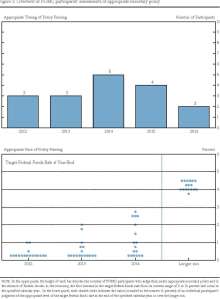Ten More Years To Recover?
March 2022. That is the point at which, according to eurodollar futures prices, three month Libor will reach the heady yield of 4%. Ten years from now until money market yields are restored to “equilibrium” as defined by the FOMC in their rate forecast issued for their January 24-25 meeting earlier this year (reproduced below). The time to reach equilibrium is not defined in their forecast, so plausibly their forecast could be consistent with market interest rates. But I suspect that if asked whether it’ll take ten years for conditions to return to normal, Ben Bernanke would sound somewhat more optimistic than that. Or put another way, if during one of his testimonies before Congress he suggested that we have another ten years of digging to get out of the economic hole we dug in ’07-’08, many Congressmen might take the view that this is far too long.
So the bond market disagrees with this outlook. Bond investors believe we are ten years away from full recovery, while the government believes or hopes that this is far too pessimistic. Forecasts can differ, but meanwhile I keep returning to the fascinating optics of the Federal Reserve imposing on the market (through Operation Twist and its predecessors) long term interest rates that reflect market forecasts they themselves find too pessimistic. The only way to reconcile the Fed’s actions with its forecast is to acknowledge that its bond purchases are uneconomic – indeed, they are intended to be so. As the logic goes, maintaining stimulative interest rate policies is the best way to assure that ultimate recovery and an improved labor market both transpire.
It’s rare that a central bank provides so much information about its thinking. An easy way to square the circle would be for the FOMC to produce rate forecasts that are consistent with the yields at which they’re buying bonds. It would ensure consistency between their actions and their forecasts, but to their credit the Fed is promoting far greater transparency than they did under Greenspan. Consequently, presuming that the FOMC doesn’t seriously believe it’ll be ten years before a return to equilibrium interest rates, they are investing at yields too low for any commercially driven bond buyer. This is not even a guess; the Fed is telling you so! The Fed doesn’t need to make profitable investments, and they likely expect to hold what they own until maturity. But if you could catch Bernanke at an unguarded moment, perhaps over a glass of wine with no press nearby, he would surely acknowledge this incongruity and justify it based on the Fed’s twin mandate of promoting full employment consistent with stable inflation. The Fed is doing what they’re supposed to. And they are explaining it as plainly as anyone could hope. Today’s bond buyer needs to be a very definitely not-hold-to-maturity type to make a profitable investment in ten year treasuries at 2.3% (or corporate bonds tethered through credit spreads to this return-free yield). If it turns out badly because the Fed starts raising rates with a view to reaching their longer run objective before 2022, it’s because the investor didn’t become a trader quickly enough.
Jeffrey Lacker, President of the Richmond Fed, thinks rates may need to rise as soon as next year. He is presumably one of the dots in the chart reproduced below, and no doubt one of the more hawkish. How fascinating to be able to ask him what he thinks of current interest rates. In fact, he’s already told you.
